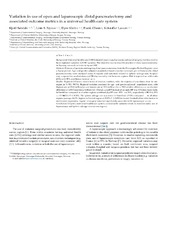| dc.contributor.author | Søreide, Kjetil | en_US |
| dc.contributor.author | Nymo, Linn Såve | en_US |
| dc.contributor.author | Kleive, Dyre | en_US |
| dc.contributor.author | Olsen, Frank | en_US |
| dc.contributor.author | Lassen, Kristoffer | en_US |
| dc.date.accessioned | 2020-04-08T08:00:07Z | |
| dc.date.available | 2020-04-08T08:00:07Z | |
| dc.date.issued | 2019 | |
| dc.Published | Søreide K, Nymo LS, Kleive D, Olsen F, Lassen K. Variation in use of open and laparoscopic distal pancreatectomy and associated outcome metrics in a universal health care system. Pancreatology. 2019;19(6):880-887 | eng |
| dc.identifier.issn | 1424-3903 | |
| dc.identifier.issn | 1424-3911 | |
| dc.identifier.uri | https://hdl.handle.net/1956/21810 | |
| dc.description.abstract | Background: Universal health care (UHC) should ensure equal access to and use of surgery, but few studies have explored variation in UHC systems. The objective was to describe practice of distal pancreatectomy in Norway covered exclusively by an UHC. Methods: Data on all patients undergoing distal pancreatectomy from the Norwegian Patient Register over a 5-year period. Age- and gender-adjusted population-based resection rates (adj. per million/yr) for distal pancreatectomy were analysed across 4 regions and outcomes related to splenic salvage rate, hospital stay, reoperation, readmissions and 90-day mortality risk between regions. Risk is reported as odds ratio (OR) with 95% confidence interval (c.i.). Results: Regional difference exist in terms of absolute numbers, with the majority of procedures done in one region (n = 331; 59.7%). Regional variation persisted for age- and gender-adjusted population-rates, with highest rate at 23.8/million/yr and lowest rate at 13.5/mill/yr (for a 176% relative difference; or an absolute difference of +10.3 resections/million/yr). Overall, a lapDP instead of an open DP was 3.5 times more likely in SouthEast compared to all other regions combined (lapDP rate: 83% vrs 24%, respectively; OR 15.4, 95% c.i. 10.1–23.5; P < 0.001). The splenic salvage rate was lower in SouthEast (19.9%) compared to all other regions (average 26.5%; highest in Central-region at 37.0%; P = 0.010 for trend). Controlled for other factors in multivariate regression, ‘region’ of surgery remained significantly associated with laparoscopic access. Conclusion: Despite a universal health care system, considerable variation exists in resection rates, use of laparoscopy and splenic salvage rates across regions. | en_US |
| dc.language.iso | eng | eng |
| dc.publisher | Elsevier | eng |
| dc.rights | Attribution CC BY-NC-ND | eng |
| dc.rights.uri | http://creativecommons.org/licenses/by-nc-nd/4.0/ | eng |
| dc.title | Variation in use of open and laparoscopic distal pancreatectomy and associated outcome metrics in a universal health care system | en_US |
| dc.type | Peer reviewed | |
| dc.type | Journal article | |
| dc.date.updated | 2020-02-14T07:01:05Z | |
| dc.description.version | acceptedVersion | en_US |
| dc.rights.holder | Copyright 2019 Elsevier | |
| dc.identifier.doi | https://doi.org/10.1016/j.pan.2019.07.047 | |
| dc.identifier.cristin | 1736727 | |
| dc.source.journal | Pancreatology (Print) | |
| dc.source.pagenumber | 880-887 | |
| dc.identifier.citation | Pancreatology. 2019;19(6):880-887 | |
| dc.source.volume | 19 | |
| dc.source.issue | 6 | |

